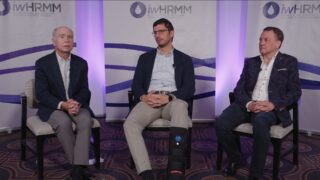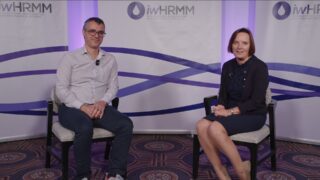Ken Anderson:
I’m Ken Anderson from Dana-Farber Cancer Institute in Boston, and I’m here with my colleagues today.
Francesco Maura:
I’m Francesco Maura from Memorial Center in New York.
Mehmet Samur:
And I’m Mehmet Samur from Dana-Farber Cancer Institute in Boston.
Ken Anderson:
And we’re here at the second meeting of the high-risk multiple myeloma. It’s been a very exciting time. We’ve made amazing progress in multiple myeloma, arguably curing some patients now, but there remains high-risk multiple myeloma, which in spite of all of our efforts, patients have early relapse of their disease and shortened survival. So maybe I can just start the discussion and say, Dr. Maura, you talked about what is high-risk multiple myeloma now in the era of immune therapies, which have been so effective, are we getting closer with immune therapies to having an impact on high-risk multiple myeloma?
Francesco Maura:
Well, I think the fact that we are changing the definition, we changed this year the definition, and without immunotherapy data, and making some alterations that were high risk before, not high risk anymore, I think it tells that the field has made significant progress in the last 15, 20 years. And in the last years, this development of these fantastic therapies, of course, will further change the landscape of features that are at risk, and will introduce new ones. So, I think the importance in the next years is not just developing these therapies and focusing on how many we can maybe cure, but also how many we don’t, how many we fail, and who are these patients, and profile them more carefully. Because, as we show, some alterations may be very uncommon, like IKAROS-3 deletion. It’s like less than 1% of patients. But these patients do not respond to lenalidomide, to teclistamab, to CAR-T, and the outcome is very poor. So I think we also need to develop better statistical models to capture not just the most frequent event, but also the events that really matter for individual patients.
Ken Anderson:
Fair enough. And Dr. Samur, you talked about some new characteristics that might identify high-risk multiple myeloma. Can you comment on what some of your studies have shown?
Mehmet Samur:
Yeah, I think in the current era, we use the definition that represents the majority of the high-risk patients, but not clearly making a perfect cut. And what we have been discussing in the first two sessions with the genomic data, Francesco has been sharing the RNA-based predictions that Paola has discussed, I discussed, and also some of the microenvironment data we are seeing from others as discussed is coming to the point that beyond looking at, as Francesco was saying, looking at the frequent events, we probably need to look at other information as well. We can look at less frequent events. We can look at events measured by other assays to actually accumulate a more cumulative risk model that may be actually able to identify these high-risk patients. The other point is being that, again, we have been looking at some of the progression data to define the risk, but the progression is depending on the treatment. And as the treatment evolves, the time we see on the progression-free survival time increases. Overall survival time is definitely getting much better than what we had before. Accounting for the treatment, accounting for these new immunotherapy agents. And I think that will eventually also change the endpoint we take to define the risk based on what we have been seeing from MIDAS and other studies. Maybe MRD will replace what these classical features we have been looking at. I think by combining all this information into one plate, we still have some way to go to identify patients who would be doing bad with any type of treatment. And once we identify that population that is the unmet need, then we would be looking further what actually can help them beyond what is available in our arsenal today.
Ken Anderson:
Fair enough. And I’ll just mention I’ve had a long-term interest in the microenvironment in multiple myeloma. And so I’ve really talked here a little bit about how genomic or even epigenomic changes in the myeloma cell can actually impact the host response. And I’ll just mention, in particular, this KDM6A loss in a myeloma cell regulates CD38 expression, so responsiveness to daratumumab, but also responsiveness to NK cells by down-regulating CD48. And so, by restoring using an EZH2 inhibitor, KDM6A, you can restore daratumumab responsiveness, but also NK cell activity. It’s just an example of something going on, in this case, epigenomically in a tumor cell that’s impacting the host. And the other concept that I mentioned, which I think is really exciting, is this immunogenic cell death idea. The concept is that the myeloma cell killed by a variety of strategies can be taken up by dendritic cells or macrophages and in turn trigger an immune reaction, which it turns out being characterized by a type 1 interferon response. But importantly, it’s associated with a more prolonged response, and it’s not present in high-risk multiple myeloma. A gene called GAPARAP, identified by Dr. Annamaria Gulla, seems to be, at least in part, responsible for that lack of immunogenic cell death response. And autophagy inducers can restore the immunogenic cell death response even in the context of loss of that GABARAP gene. And the final thing I’ll say is, you know, we’ve been talking about great ways to analyze the tumor cell, incredible refined technologies that, you know, heretofore we couldn’t do, single cell sequencing, etc. But I think to understand who even today responds the best to our current treatments, we need to not only study the tumor cell, but really characterize what is going on in the host, what’s the immune response in that case, what are the target antigens? Really understand, understanding in the really super responders, and then maybe that can give us clues to address the high-risk myeloma as well.
Mehmet Samur:
I think what you are bringing is very important from different angles. As the person who has been seeing many different patients at many different conditions for years, I’m sure you already have cases where you have seen by any criteria we have today would be considered as high risk, but they’ve been doing maybe more than a decade or maybe more than two decades just fine with the care. Finding the microenvironment features that would actually help them to achieve that point is very critical. And we don’t have much clue as of today, I think, on those long-term remission patients with the high-risk characteristics.
Ken Anderson:
I couldn’t agree more. And I think the other thing maybe I’ll just mention or ask Dr. Maura, you know, you had a recent paper showing that unfortunately lack of response to daratumumab or isatuximab can actually be related to biallelic deletion of CD38. And I guess the question I have is we have all these wonderful treatments now, the monoclonal antibodies, the bispecific T-cell engagers, the CAR T-cells, but shouldn’t we be more precisely evaluating patients before we use these agents for lots of reasons?
Francesco Maura:
I love this question. So I think what we are doing today is what always happens when you start something thinking that’s the right way to do it, and then you just keep going. And then you realize, because in medicine things, unfortunately for patients, doesn’t occur by day, but by years or decades, you realize that that may not be the best strategy. So, you know, we start with lenalidomide, and then we convince ourselves that lenalidomide continuously maintenance was the best strategy. Now some people say maybe you should stop in some patients, and the same with daratumumab. We started, we stopped, now we want to continue, but then in some patients, you lose CD38. And that, of course, is bad for subsequent therapy. So I think we just need to learn and be… I think as a proactive approach, we should just probably try to identify different strategies how to better use these drugs. I think we have the drugs right now. Actually, we have too many drugs. The problem now is, how should I treat my patient in first relapse or second relapse? I have, like, five different options. CAR-T, bispecific, BCMA, GPRC5D, FcRH5, soon to come. You know, there are so many things. And the question is, how do we treat this patient? Like, be specific. I don’t think we should treat until progression. And I think new drugs are developing, and new trials investigating fixed duration, less toxicity, maybe less mechanisms of resistance. So I think we just have to learn and really work closely with clinical trial and scientific community together in the most synergic possible way, including pharma, of course, and really try to better understand how we can do this in a better way. Because I think we already have a lot of resources. We just need to find the best way to use it.
Ken Anderson:
Totally agree. And I think it’s profiling the myeloma side, but it’s profiling the immune side. I think it would be so beneficial for informing the best use, but also probably expanding access of these agents to patients who need them. I’m just going to finish by mentioning comments about beta-2-microglobulin, which has been used for many years as a marker of tumor mass in myeloma. But I mentioned now that the new recognition that it’s actually quite immunosuppressive and it down-regulates this immunogenic cell death response that I’ve mentioned and can be targeted with novel strategies to try to enhance immunity in constitutive and also immune responses in patients who are treated with novel agents. I wanted to just finish with that because tragically Brian Durie recently passed away and he was a giant in multiple myeloma for lots of reasons. But the two that I would just mention here is there is what’s called the Durie-Salmon staging system from the 1970s. And it was based on beta-2-microglobulin as a marker of tumor burden. And here we are 50 years later understanding more about the biology of that marker and hopefully leading to novel insights into therapy. The other thing Brian Durie did together with his wife Susie Durie is start the International Myeloma Foundation. That has grown over the last nearly 50 years to actually educate caregivers and patients alike and done more probably than any other organization on earth to assure that these advances that we’re hearing about here today have actually been around the world shared, and as a consequence, access to patients and their families has been increased. So he was a giant because he made seminal scientific contributions, but he also is a giant because of the science being made or being important and counting for patients and their families all around the world. So we’ll miss him, but we will be inspired by his example.























